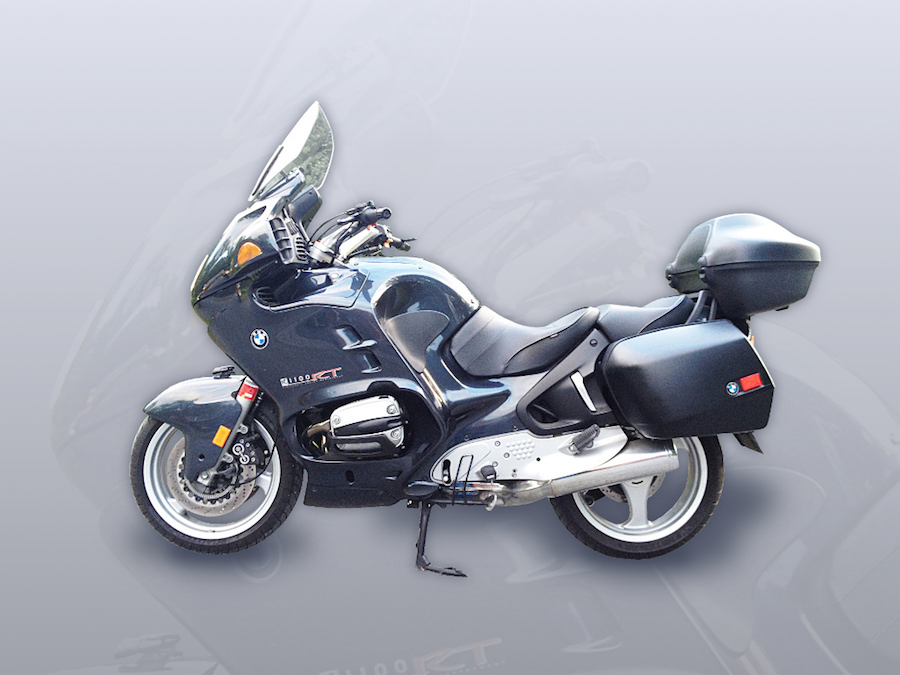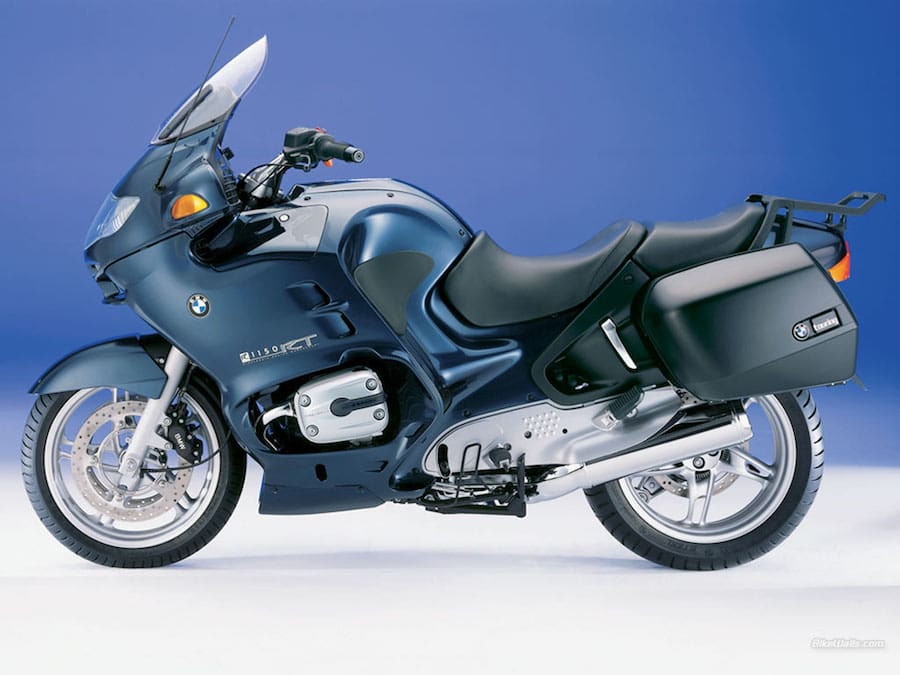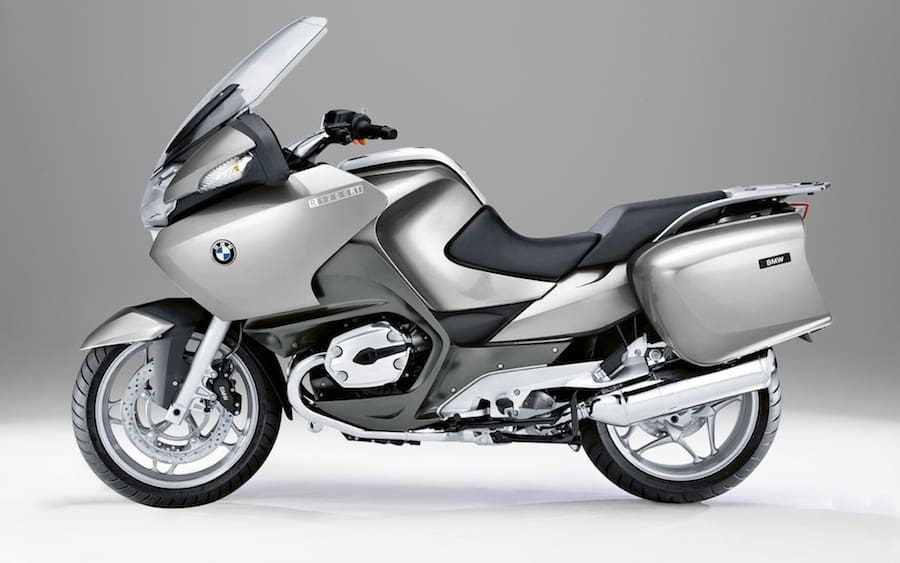Prior to the release of the R 1200 RT in 2005, BMW’s RT-series touring bikes had represented the gold standard for the category in terms of the model’s impressive combination of performance, comfort and tech-spec. Then the comprehensively redesigned R 1200 RT arrived and raised the bar several notches higher, winning the Munich-based company plaudits from fans of top-shelf tourers around the world.
The 1200 RT is a more responsive bike than the much admired R 1150 RT it replaced, thanks to a 15 per cent power boost (to 82kW) and a 20kg weight loss (to 229kg dry). The revised air/oil-cooled, flat-twin (‘boxer’) engine is housed in a redesigned two-piece tubular-steel frame. The suspension combines the unique Telelever up front with the Paralever rear. A powerful, partially linked ABS set-up provides braking that’s a great match for the big tourer’s needs.
Rider and passenger ride sumptuously on all-day-comfortable seats, protected from the elements by a substantial fairing with an electrically adjustable screen. The ergonomics suit a wide range of rider sizes and shapes. Rider seat height adjusts from 820-840mm.
Tacho and speedo are easy-to-read analogue units. Supplementary digi-displays vary according to the range of options fitted. Other options included heated grips, heated seats, cruise control, CD/radio audio system, electronic suspension adjustment, tyre-pressure monitoring and on-board computer.
The factory hard-panniers have an easy-to-use locking and attachment system. If you’re lucky you might find an example also fitted with the factory top-box, which looks the part and adds significantly to luggage-carrying capacity – perfect for the long-distance touring fraternity.
Although the bike is no lightweight at 229kg, its low-set, horizontally opposed engine magically ‘lightens’ the bike once you’re rolling. However, you’re conscious of its width when you’re trying to thread your way through the urban log-jam.
Low-mounted mirrors add to the demands of lane-splitting, being about the same height as car mirrors. A plus is that the mirrors actually protect your hands from cold wind and rain. And they work well once you adapt to looking down to find them and you get used to seeing your rear-view snapshot under the reflection of your gloved knuckles.
Throttle response is linear and smooth. Clutch action is light and the six-speeder’s gear selection is precise and accurate, despite the typical BMW ‘clunk’, particularly on downshifts.
Even when touring briskly, two-up with luggage, I’ve always found that the R 1200 RT had plenty of power and grunt for every situation. When you short-shift the big, torquey donk it pulls like a train and you can almost feel each power pulse from its big pistons as it gets going. It’s equally enjoyable when you rev it out through the gears, chasing the horizon through the sweepers, forcing it to sound uncharacteristically raucous. The 27-litre tank gives the RT a safe touring range of over 450km.
While ‘Telelever’ first-timers take a while to adapt to its ‘no-dive’ behaviour, especially when braking hard into tight bends, the reality in these conditions is that it’s very forgiving of both late braking and mid-corner bumps. A big RT cuts an impressive swathe through the twisties, outhandling very competent competitors such as Yamaha’s FJR1300 and Honda’s ST1300.
If white is your colour and you can cope with people in front slowing down all the time, ex-Police R 1200 RTs turn up at discounted prices here and there.
This review covers the single-overhead-cam version from 2005 through 2009, prior to 2010’s twin-cam model. Some reckon the harsher braking response of the 2005-06 models (with servo boost) makes them less desirable, but these are all competent motorcycles that bring a touch of luxury to long-distance touring. I would look for an example that’s been well cared for and combines good service records with an impressive option list.
What to look for
The R 1200 RT is a well-designed and well-built motorcycle that takes the kilometres in its stride.
BMW expert Chris Roberts of BM Motorcycles in Ringwood (Vic) says one potential issue is cracking of the alloy hub that carries the rear wheel and brake disc. Hub condition can be checked by a visual inspection without removing the wheel.
As usual, look for damage and signs of neglect, and factor in the cost of worn consumables such as tyres, brake pads and brake rotors.
The ideal example is a clean bike with detailed service records.
Service history
Although the R 1200 RT is very reliable, issues with its sophisticated electronic systems are best handled by specialists with the right equipment.
DIY owners can perform basic servicing, provided care is taken to prevent cosmetic damage when removing, handling and refitting bodywork. A real bonus on a ‘boxer-twin’ is easy access for valve clearance work. And it’s an old-school locknut-and-screw set-up.
Roberts recommends that gearbox oil be changed at each 10,000km service.

1. New 1170cc engine, first seen in the R 1200 GS, received hotter cams and a higher compression ratio in RT guise.
2. The engine is a load-bearing link between the separate tubular-steel front and rear frame sections.
3. Slick six-speed gearbox features helical gears for quieter operation and ratios to match engine characteristics.
4. Fairing was designed in a wind-tunnel and also provides more room for tall riders’ knees than its R 1150 RT predecessor.
The ancestry

BMW R 1150 RT
2001 – Engine capacity, torque and power boosted performance for the R 1150 RT. Brakes were now linked and the previous five-speed gearbox was replaced by a new six-speed unit.

BMW R 1100 RT
1995 – The heavily revised R 1100 RT delivered a 50 per cent power increase from its all-new ‘oil-head’ engine and featured ABS brakes as standard.

BMW R100 RT
1979 – The R 100 RT marks BMW’s entry into the ‘full-dress’ tourer category. It featured a full touring-fairing with ventilation louvres, adjustable screen and lockable storage.
Price Guide
New Price
$27,600 (2005)
$28,000 (2009)
Secondhand
$13,400 – $18,800

WORDS ROB BLACKBOURN
PHOTOGRAPHY AMCN ARCHIVES











